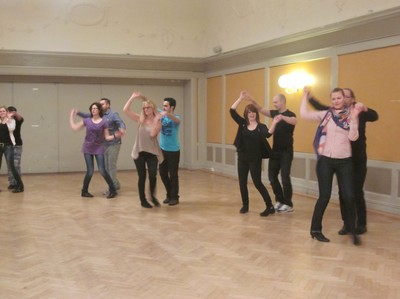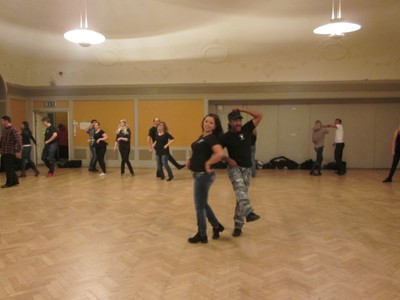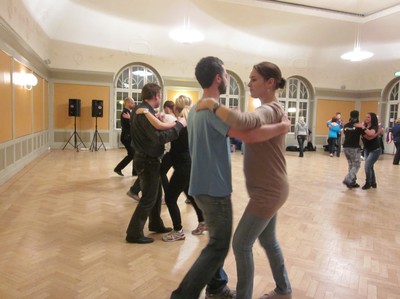Ett reportage om Tropical!
Hej på er!
Allt fler och fler studenter kontaktar oss och vill gärna göra skolarbeten om dansen och om Tropical Sundsvall. Vi tycker att det är jätteroligt! Det är alltid jättespännande att läsa och se vad ni har åstadkommit och vi hoppas såklart att ni får fina betyg på era arbeten. Vi tycker att ni alla är jätteduktiga! =)
Minns ni att jag bloggade förut och visade Alina Fischers fina artikel om Club Bachata? Den artikeln kan ni läsa här: http://tropicalsundsvall.blogg.se/2012/march/ett-skolarbete-om-dansen.html
Förutom artikeln har Alina också skrivit ett långt reportage om Tropical Sundsvall och danskurserna! Det är superbra skrivet och självklart vill vi dela med oss utav det till er läsare! =)
La alegría y los bailes – Dancing Latin-American dances at “Tropical Sundsvall” in Sweden
“Uno, dos, tres!” Hector Oviedo Abreus sonorous voice echoes through the large room. Immediately couples from all parts of the world start dancing, smoothly moving to the Caribbean sounds of bongos and guitars and practice different series of steps and figures. Women shake their hips while men guide them with their hands. Most of them have an expression of highest concentration on their faces. Lina Törnqvist thoroughly observes the scene and encourages the dancers with supporting words.

It is Monday, 8 p.m. – I am at Kårhuset in Sundsvall where the dancing lessons of “Tropical Sundsvall” take place, excited for an evening full of salsa and joy. Abreu and Törnqvist, the dancing instructors and founders of the school just started their lesson. Suddenly the music stops, silence fills the room and people stop to dance. Abreu crosses the room and pulls Törnqvist towards him while smiling. Obviously the students had made some mistakes in dancing. With the patience of long-standing teachers, Abreu and Törnqvist show the figure again. Both of them get lost in an elegant sequence of turns, pirouettes and steps.
While they are dancing I recognize the intimacy resulting from their 6-year-lasting dancing experience together. They intuitively seem to know how the other one moves, and reacts on their own movements. “Wow this is gonna be hard.” Stopped in my thoughts I look at my dance partner, Mehdi Dadashpour, a young student from Iran, who just said these words. I put an encouraging smile on my face. The goal for today would be to dance this sequence as Abreu and Törnqvist just showed us. “Musica!” Abreu shouts and the bongos start again.

Abreu originates from Cuba where he has been a dancing teacher his whole life. Six years ago he left his country to implement Latin-American dances in Sweden. He met Törnqvist in a Salsa class in Sundsvall, where he was working with another dancing teacher. “After that Hector needed a dance partner to show all the figures in the class and do some performance,” Törnqvist said.
The two became a constant couple in terms of dancing. As the other dancing teacher moved to Stockholm both of them decided to open their own dancing school in 2010. The idea of “Tropical Sundsvall” was born. The school is the only one of its kind in Sundsvall. “We named us ‘Tropical Sundsvall’ because we want the people to become a tropical feeling,” Törnqvist said. This aim was fulfilled. “Every month more and more people came to class.” The dancing school started to increase and gain popularity.

These words perfectly reflect the lesson I witnessed. Far more than 40 people gathered at Kårhuset this Monday to improve their dancing abilities. “Dancing makes me forgetting all worries, I love to dance,” Ullamaja Remes said. She has been coming to “Tropical Sundsvall” with her husband since its founding.
“This is the most entertaining activity we have here in Sundsvall,” dancing student Saeed Haddadi Makhsous said. “I can follow the lessons very easily.” On this Monday those efforts for their students of Abreu and Törnqvist are already visible. Salsa is a vivid and dynamic dance: Basic dance step, a circulation around the axis, turn to the right for the women – no longer a challenge for the students.
Laughter from the dancers drowns the singer out of the CD-player. Suddenly I recognize a blond girl taking pictures from each couple. Ida Ingemarsson takes care of the “Tropical Sundsvall dansblogg” and supports Törnqvist with the marketing issues of the school. “Oh it’s so good,” she said when being asked about the teaching style of Abreu and Törnqvist. “They break it down to zero and then build it up, they really care about that you will learn and they have patience.”

Besides Salsa Törnqvist and Abreu also offer Bachata, a much more sensual dance. Couples get closer while dancing it; the bodies literally melt together and form a unity. Solo dances are also in the teaching program: Reggaeton is a dance which requires a high ability of body control. Several parts of the body are moved independently from each other. Finally “Tropical Sundsvall” has a Latin-based fitness course, Cuba-Mix, which is for workout with Latin-American music.
During their classes Abreu and Törnqvist try to support their students whenever they can. As I fail in a special movement Törnqvist shows the movement once again.
She started dancing seven years ago. Together with her mother she went to the course in which she also met Abreu. “We went to the salsa class with another teacher and after that I fell in love with the dance and salsa,” she explained to me. “Before that I didn’t dance but now I have seen another world.” While saying that she starts to smile and sparkles appear in her eyes. Her passion evolved until she finally became a dancing teacher herself who now transfers this feeling to her students: “I want them to feel the passion in the dance, I want the people get to love the dance like me!”

According to students and supporters she succeeds in her goal. Most of them feel comfortable and share her passion while dancing. “The teachers make you feel like a family member,” Dadashpour said. “You feel like home”. This is the feeling Ingemarsson attributes to the school aswell: “It’s so fantastic, we are like a whole family, a very very big family and I feel this very good atmosphere when we are dancing.”

At the end of class everybody has been caught by this atmosphere. All of the students succeeded in dancing today. The music is slowly fading out and Törnqvist starts to say goodbye to people. Now I am able to talk to Abreu. He is waiting patiently for Törnqvist to translate my questions. His only fluent language is Spanish but he is studying Swedish and improving in it. As Törnqvist comes and the interview starts, he just thinks about questions a very short moment and then answers quickly while his eyes seem to search for something in a far distance that is not visible for the other people surrounding him.

Abreu came to Sweden because he wanted to teach Swedes how to dance. He already knew many Swedes through courses in Cuba. Now Abreu calls the whole of Europe his working place. He has been to festivals in Spain, Italy and many other countries. “This is why Sweden is a good country to live in, it is close to all the other countries in Europe,” Törnqvist translates his words.
Abreu has been dancing all of his life - his whole family consists of professionals not only in dancing, but also in music and arts. “I started dancing already when I was in my mother’s womb,” he said with a smile on his face. When he gives classes his aim is to transfer the good feelings and the happiness the dance gives you. “La alegría (the joy),” he said, is what everything is about.

After saying goodbye to Törnqvist and Abreu I leave the building with a good feeling. I will definitely return to “Tropical Sundsvall”. I still feel the spirit and the joy the class gave to me or as Ingemarsson put it: “When I finish with course in the evening I have so much energy, it’s hard to go to sleep then.” Latin-American dances definitely carry the potential of falling in love with them and “Tropical Sundsvall” is a perfect place to start with that.
Thank you so much for your great article Alina! =)
Stor Kram!
